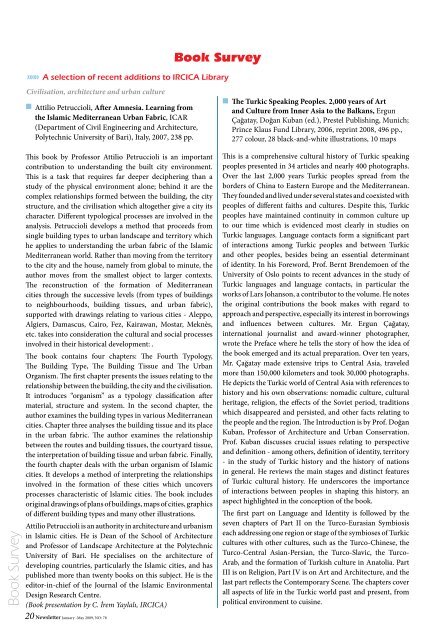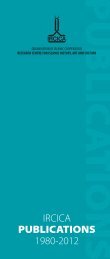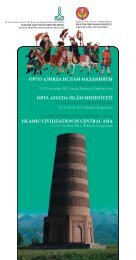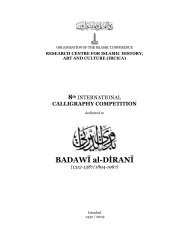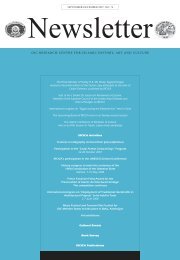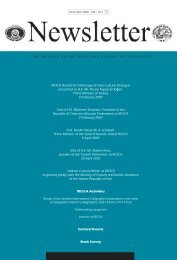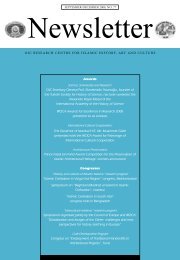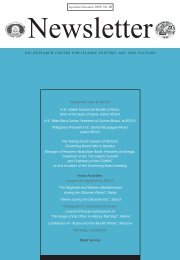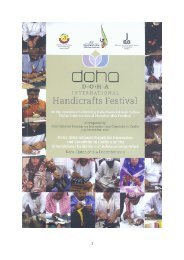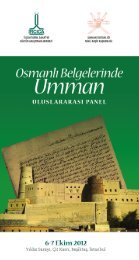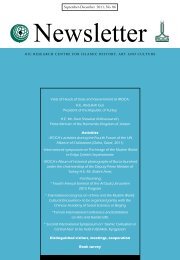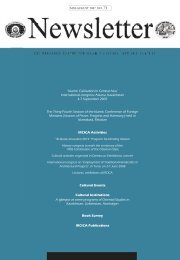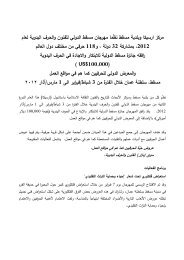IRCICA Newsletter Issue 78
IRCICA Newsletter Issue 78
IRCICA Newsletter Issue 78
You also want an ePaper? Increase the reach of your titles
YUMPU automatically turns print PDFs into web optimized ePapers that Google loves.
»»»<br />
Book Survey<br />
A selection of recent additions to <strong>IRCICA</strong> Library<br />
Civilisation, architecture and urban culture<br />
Attilio Petruccioli, After Amnesia. Learning from<br />
the Islamic Mediterranean Urban Fabric, ICAR<br />
(Department of Civil Engineering and Architecture,<br />
Polytechnic University of Bari), Italy, 2007, 238 pp.<br />
The Turkic Speaking Peoples. 2,000 years of Art<br />
and Culture from Inner Asia to the Balkans, Ergun<br />
Çağatay, Doğan Kuban (ed.), Prestel Publishing, Munich;<br />
Prince Klaus Fund Library, 2006, reprint 2008, 496 pp.,<br />
277 colour, 28 black-and-white illustrations, 10 maps<br />
Book Survey<br />
This book by Professor Attilio Petruccioli is an important<br />
contribution to understanding the built city environment.<br />
This is a task that requires far deeper deciphering than a<br />
study of the physical environment alone; behind it are the<br />
complex relationships formed between the building, the city<br />
structure, and the civilisation which altogether give a city its<br />
character. Different typological processes are involved in the<br />
analysis. Petruccioli develops a method that proceeds from<br />
single building types to urban landscape and territory which<br />
he applies to understanding the urban fabric of the Islamic<br />
Mediterranean world. Rather than moving from the territory<br />
to the city and the house, namely from global to minute, the<br />
author moves from the smallest object to larger contexts.<br />
The reconstruction of the formation of Mediterranean<br />
cities through the successive levels (from types of buildings<br />
to neighbourhoods, building tissues, and urban fabric),<br />
supported with drawings relating to various cities - Aleppo,<br />
Algiers, Damascus, Cairo, Fez, Kairawan, Mostar, Meknès,<br />
etc. takes into consideration the cultural and social processes<br />
involved in their historical development: .<br />
The book contains four chapters: The Fourth Typology,<br />
The Building Type, The Building Tissue and The Urban<br />
Organism. The first chapter presents the issues relating to the<br />
relationship between the building, the city and the civilisation.<br />
It introduces “organism” as a typology classification after<br />
material, structure and system. In the second chapter, the<br />
author examines the building types in various Mediterranean<br />
cities. Chapter three analyses the building tissue and its place<br />
in the urban fabric. The author examines the relationship<br />
between the routes and building tissues, the courtyard tissue,<br />
the interpretation of building tissue and urban fabric. Finally,<br />
the fourth chapter deals with the urban organism of Islamic<br />
cities. It develops a method of interpreting the relationships<br />
involved in the formation of these cities which uncovers<br />
processes characteristic of Islamic cities. The book includes<br />
original drawings of plans of buildings, maps of cities, graphics<br />
of different building types and many other illustrations.<br />
Attilio Petruccioli is an authority in architecture and urbanism<br />
in Islamic cities. He is Dean of the School of Architecture<br />
and Professor of Landscape Architecture at the Polytechnic<br />
University of Bari. He specialises on the architecture of<br />
developing countries, particularly the Islamic cities, and has<br />
published more than twenty books on this subject. He is the<br />
editor-in-chief of the Journal of the Islamic Environmental<br />
Design Research Centre.<br />
(Book presentation by C. İrem Yaylalı, <strong>IRCICA</strong>)<br />
20<br />
<strong>Newsletter</strong> January -May 2009, NO: <strong>78</strong><br />
This is a comprehensive cultural history of Turkic speaking<br />
peoples presented in 34 articles and nearly 400 photographs.<br />
Over the last 2,000 years Turkic peoples spread from the<br />
borders of China to Eastern Europe and the Mediterranean.<br />
They founded and lived under several states and coexisted with<br />
peoples of different faiths and cultures. Despite this, Turkic<br />
peoples have maintained continuity in common culture up<br />
to our time which is evidenced most clearly in studies on<br />
Turkic languages. Language contacts form a significant part<br />
of interactions among Turkic peoples and between Turkic<br />
and other peoples, besides being an essential determinant<br />
of identity. In his Foreword, Prof. Bernt Brendemoen of the<br />
University of Oslo points to recent advances in the study of<br />
Turkic languages and language contacts, in particular the<br />
works of Lars Johanson, a contributor to the volume. He notes<br />
the original contributions the book makes with regard to<br />
approach and perspective, especially its interest in borrowings<br />
and influences between cultures. Mr. Ergun Çağatay,<br />
international journalist and award-winner photographer,<br />
wrote the Preface where he tells the story of how the idea of<br />
the book emerged and its actual preparation. Over ten years,<br />
Mr. Çağatay made extensive trips to Central Asia, traveled<br />
more than 150,000 kilometers and took 30,000 photographs.<br />
He depicts the Turkic world of Central Asia with references to<br />
history and his own observations: nomadic culture, cultural<br />
heritage, religion, the effects of the Soviet period, traditions<br />
which disappeared and persisted, and other facts relating to<br />
the people and the region. The Introduction is by Prof. Doğan<br />
Kuban, Professor of Architecture and Urban Conservation.<br />
Prof. Kuban discusses crucial issues relating to perspective<br />
and definition - among others, definition of identity, territory<br />
- in the study of Turkic history and the history of nations<br />
in general. He reviews the main stages and distinct features<br />
of Turkic cultural history. He underscores the importance<br />
of interactions between peoples in shaping this history, an<br />
aspect highlighted in the conception of the book.<br />
The first part on Language and Identity is followed by the<br />
seven chapters of Part II on the Turco-Eurasian Symbiosis<br />
each addressing one region or stage of the symbioses of Turkic<br />
cultures with other cultures, such as the Turco-Chinese, the<br />
Turco-Central Asian-Persian, the Turco-Slavic, the Turco-<br />
Arab, and the formation of Turkish culture in Anatolia. Part<br />
III is on Religion, Part IV is on Art and Architecture, and the<br />
last part reflects the Contemporary Scene. The chapters cover<br />
all aspects of life in the Turkic world past and present, from<br />
political environment to cuisine.


